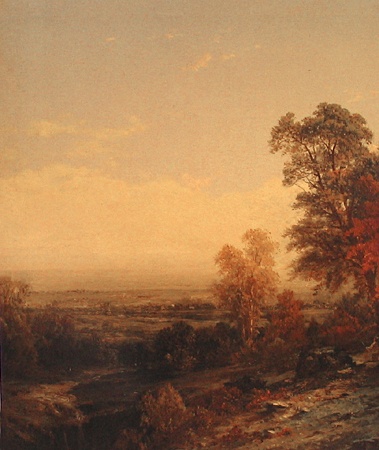Westmoreland Museum of American Art, Greensburg, Pennsylvania. August 7 - October 23, 2005
Samuel Dorsky Museum of Art at the State University of New York at New Paltz. February 4-May 14, 2006
Everhart Museum, Scranton 2007
Museum of the Shenandoah Valley, Winchester, VA, Oct 2010 - Jan 2011
Reading Public Museum, Reading PA . February 19-June 5, 2011
Blanton Museum of Art at The University of Texas at Austin. February 26–May 13, 2012
American Scenery: Different Views of Hudson River School Painting, featuried116 paintings from the Hudson River School, a loose collective of artists working in upstate New York from 1825-1875, whose works comprised America’s first native artistic style.
Thomas Prichard Rossiter (1818-1871) Niagara Falls, 1858 Oil on canvas, 13 1/2 x 24 inches Private collection
Artists included in the Hudson River School, and represented in exhibition, are Thomas Cole, Jasper Francis Cropsey, Sanford Robinson Gifford, Asher B. Durand, Frederic Edwin Church, John Frederick Kensett, and John William Casilear, among others.
John William Casilear (1811-1893), Niagara Falls, 1872, oil on canvas, 13 x 23 inches, private collection, courtesy of Westmoreland Museum of American Art, Greensburg, Pennsylvania;
Assembled from a single private collection, this touring exhibition is organized by the Westmoreland Museum of American Art in Greenburg, Pennsylvania.
Sanford Robinson Gifford, A Lake Twilight, 1861, oil on canvas, private collection
(courtesy of Westmoreland Museum of American Art)
Founded in 1825 by Thomas Cole, the Hudson River School drew its inspiration from America’s landscape. Its artists shared a spiritual awe of nature and believed in the notion that the country’s untamed wilderness reflected aspects of its national character.
Jervis McEntee (1828-1891), Indian Summer, 1862, oil on canvas, 10 x 18 inches, private collection, courtesy of Westmoreland Museum of American Art, Greensburg, Pennsylvania;
American Scenery investigates the group’s shared aesthetic and philosophical principles and situates the paintings in the context of nineteenth-century American values. The exhibition’s unique point of view stresses the artist’s eye, pairing and grouping paintings that explore the visual characteristics of particular sites, or that examine the subtle changes that can be observed during varied seasons, times of day, and weather conditions.
Considered by many to be the first truly American school of painting, the Hudson River School flourished between 1825 and 1875 and celebrated the vast natural resources of the American landscape just prior to the industrialization that forever changed that landscape. The movement was embraced by three generations of artists who shared common principles which united them as a school despite their individual differences in style. Primary among these was a belief in natural religion, a deep admiration for the magnificence of the land, and a keen interest in the direct observation of nature. Most importantly was an awareness of the fresh, untamed American scenery as reflective of the optimism and independence of our character as a young nation. The style was not geographically confined to the Hudson River region, however, and
Thomas Cole's Sunset at the Arno (1837),
paired with Frederic Church's Ruins at Baalbek (1868)
were selected to compare approaches to the landscape outside of the region.
The exhibition investigates the practice of how Hudson River School artists created pairs, series, and groupings of landscape paintings that are thematically related and intended to be viewed together. Visitors are encouraged to compare and contrast how different generations of artists interpreted the majestic American landscape. Influenced by the ever-changing landscape around them, artists and works in the exhibition are organized according to nine themes, including Times of Day; Weather Conditions, Atmosphere, and Mood; Man's Impact on Nature; The Machine in the Garden.
The purpose of the exhibition is to revive the public's ability to appreciate nineteenth-century American landscape painting and to provide insight into the iconographical base that gives it greater meaning in order to more fully comprehend its achievement. This will also bring about a deeper understanding of the profound reaction our forefathers experienced when encountering the extraordinary natural bounty of America and how it was attuned to the buoyant hopes they held for their lives in this new nation.
The exhibition was accompanied by a fully illustrated catalogue published by Columbia University Press and includes full-color reproductions of all 114 paintings in the exhibition, an essay, a complete checklist, and descriptions of each pairing and grouping of paintings. The catalog's essay traces the tradition of pairs and series of paintings beginning with the medieval books of hours, through to Nicholas Poussin and Claude Lorraine whose paintings were known to and influenced the early painters of the Hudson River School. The school's founder, Thomas Cole painted in series in order to communicate his narrative themes, whose complicated imagery could not be accommodated in a single painting. Later artists of the school used other, more subtle methods of imbuing their landscapes with meaning, including using a set iconography that was known both to the artists and to their audience and included natural cycles such as seasons and times of day, light effects caused by weather, and the positioning of trees and animals within the landscape.
Nice review
Images from the exhibition
James McDougal Hart
1828-1901
On the Farmington River, 1862
Oil on canvas
19 x 32 inches
William McDougal Hart
1823-1894
Sunset in the Valley, 1870
Oil on canvas
14 x 23 _ inches
Jasper Francis Cropsey
1823-1900
On the Susquehanna, 1877
Oil on canvas
12 x 17 _ inches
Asher Brown Durand
1796-1886
Woodland Interior, c. 1855
Oil on canvas
20 x 16 inches
Sanford Robinson Gifford
1823-1880
A Lake Twilight, 1861
Oil on canvas
16 x 28 inches
John William Casilear
1811-1893
Autumn Landscape with Fisherman, c. 1865-
1870
Oil on canvas
12 _ x 10 inches
Martin Johnson Heade
1819-1904
White Mountain Landscape, Mount Washington,
1871
Oil on canvas
9 x 15 _ inches












